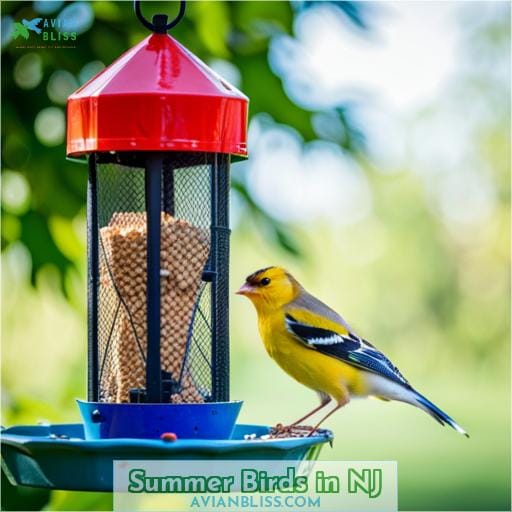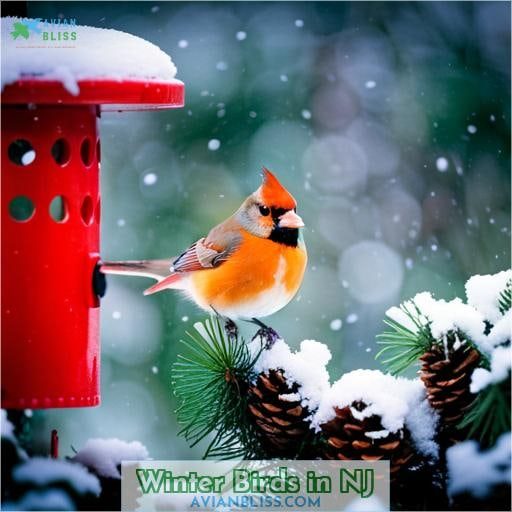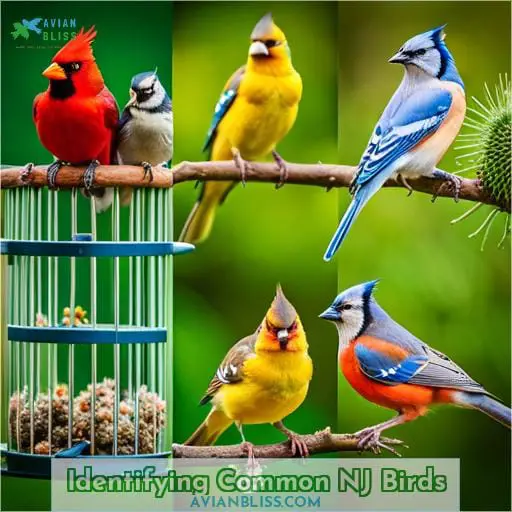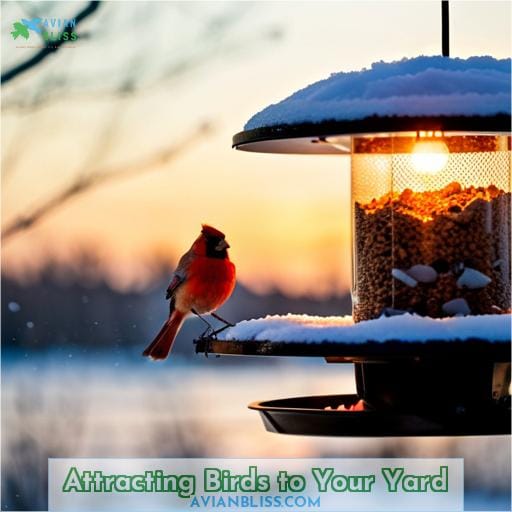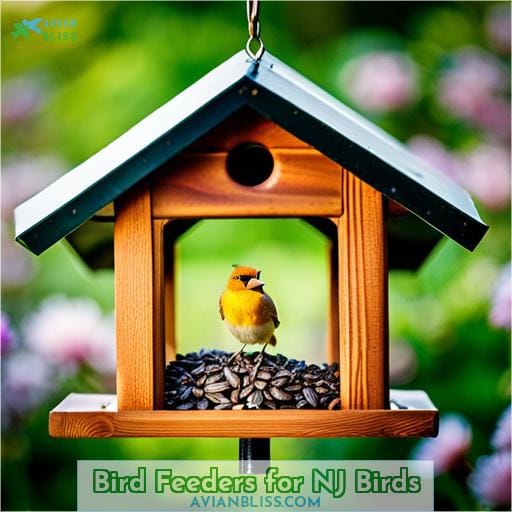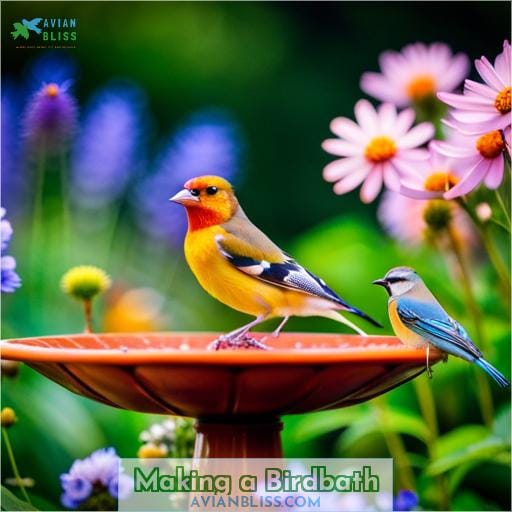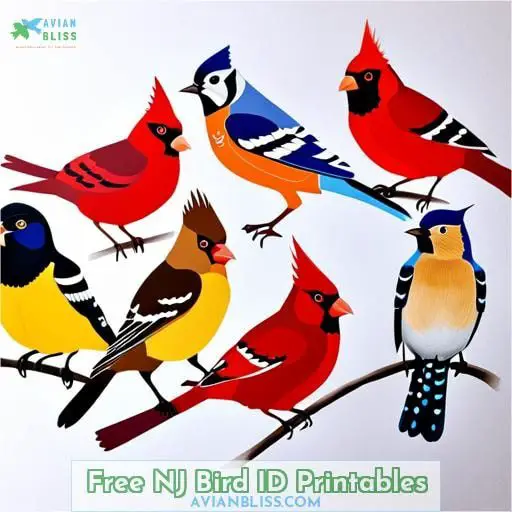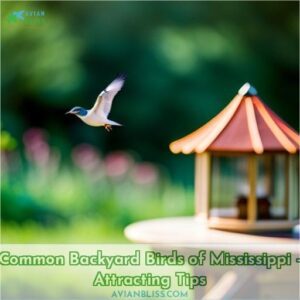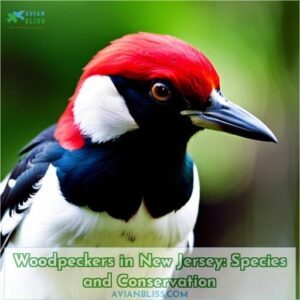This site is supported by our readers. We may earn a commission, at no cost to you, if you purchase through links.
 Whoosh! Winged wonders flutter in your backyard, eager to be observed and identified. They chirp out nature’s sweet melody, beckoning you to peek through your blinds at the bountiful birds. Their beaks peck seeds and their talons perch on limbs, feathers fluttering in the Jersey breeze.
Whoosh! Winged wonders flutter in your backyard, eager to be observed and identified. They chirp out nature’s sweet melody, beckoning you to peek through your blinds at the bountiful birds. Their beaks peck seeds and their talons perch on limbs, feathers fluttering in the Jersey breeze.
Join them on their flight to fulfill your desire for connection. Uncover their secrets, note their songs, delight in their dance. Together we’ll discover the most common backyard birds in New Jersey and enjoy their graceful grandeur.
Table Of Contents
Key Takeaways
- Offer a variety of bird feeders like tube, platform, and suet cages to attract different bird species.
- Plant native trees and shrubs that provide food and shelter for birds.
- Check eBird for recent sightings at top New Jersey birding spots before visiting to improve your chances of seeing target species.
- Join a local birding club for mentoring, field trips, and citizen science data collection opportunities.
Common Backyard Birds in NJ
You’ll likely spot a few familiar feathered friends flocking around your yard, such as the red-crested Northern Cardinal, petite Mourning Dove, and cheery American Robin. Watch for these species busily visiting feeders and fluttering between trees as you embark on backyard birding adventures this season.
Northern Cardinal
You’ll spot a male cardinal’s bright red plumage and crested head while its drab brown mate skulks in the brush.
- Look for the vivid red plumage and black facial mask of the male northern cardinal.
- Listen for the bird’s metallic chip notes and loud, whistled song.
- Offer sunflower seeds, safflower, fruit, and nuts to attract these backyard birds.
- Plant native shrubs and dense evergreens to provide nesting habitat.
Among America’s favorite backyard birds, northern cardinals frequent feeders daily. Their whistles herald spring’s arrival and brighten winter days with flashes of crimson.
Mourning Dove
The dove’s mournful cooing echoes through your yard as it perches on the feeder, its soft brown plumage and long tail a familiar sight. Mourning doves are year-round residents, recognizable by their slim bodies, pointed tails, and soothing coos.
They often gather in large flocks and fly in a distinct V formation. Peaceful and gentle, these graceful birds build flimsy nests of twigs on roofs and ledges. You can entice mourning doves by planting native shrubs with soft fruits and providing elevated birdhouses.
Their melancholy song evokes a sense of belonging amid the natural rhythms of your backyard.
American Robin
You’d often see American robins with their black heads and orange breasts hopping on lawns in spring, when over 70% of sightings occur in New Jersey. Their cheerful caroling announces warmer seasons. Watch for juveniles with speckled breasts following parents as they probe the soil for worms.
These early migrating thrushes return on similar paths annually, settling in yards and parks to build nests and lay blue eggs. Offer mealworms and fruit in platform feeders to draw more robins to your backyard refuge.
Summer Birds in NJ
Look who’s arrived in your backyard just in time for summer—the raspy meows of the Gray Catbird and raucous trills of the Red-winged Blackbird! Spot their distinctive plumages as you refill your feeders and birdbaths during these long, hot days when raising chicks takes a lot of extra energy.
Gray Catbird
See the gray catbird’s black cap and hear its cat-like meow in your yard as it visits the feeders this summer.
- Place feeders near native flowers and bushes.
- Use hopper feeders with squirrel baffles for seeds.
- Offer suet and a birdbath with safe surrounding spots for nesting.
- Position the bath near bushes but keep it open for landing.
The secretive gray catbird blends into backyard habitats. With patience, you can be rewarded by its singing and antics when it feels safe.
Red-winged Blackbird
With summer’s arrival, spot that striking blaze of crimson on the males’ wings as red-winged blackbirds descend on marshes and fields throughout New Jersey. Aggressively guarding territories, males perch conspicuously, flashing bright shoulder patches and whistling their signature odekonk-a-ree! call.
Females weave nests in cattails and crops, raising up to four broods per season. Abundant farmland habitats attract large flocks foraging on waste grains and seeds before migrating south in autumn.
Winter Birds in NJ
When the weather turns cold, you’ll start to notice two signature winter visitors flocking to your feeders: the White-throated Sparrow with its crisp facial pattern and the Dark-eyed Junco with its gray hood and neat white belly.
Keep your eyes peeled, and you’re sure to spot these hardy northern birds that have flown south to join your backyard community for the season.
The White-throated Sparrow sports a striking black and white striped head, bright white throat, and yellow lores that make it easy to identify as it scratches in the leaf litter below your feeder. Listen for its distinctive call – a clear, whistled Oh Sweet Canada, Canada, Canada.
The Dark-eyed Junco is a plump snowbird with a dark gray hood, pinkish bill, and bright white belly. It bounces along the ground in bounding bursts, flushing insects and seeds. You’ll often see small flocks streaking across open areas as they seek cover and food.
Both species breed in northern coniferous forests and migrate south for winter, where they frequent backyards, thickets, and weedy fields. Offer black oil sunflower seeds, nyjer, cracked corn, millet, and suet to attract these birds and enjoy their lively presence all season long.
With a variety of feeders and patience, you’re sure to be rewarded with sightings of these two charming winter residents.
White-throated Sparrow
Look for the White-throated Sparrow’s bright white throat and yellow spot between the eye and bill as it forages under feeders this winter.
- Prefers to feed on the ground under platform or tube feeders.
- Often found in flocks when not nesting.
- Population stable but can fluctuate locally.
- Nests in brushy clearings and forest edges across Canada.
- Attract with sunflower seeds.
The White-throated Sparrow is a welcome sight at winter feeders; its crisp plumage brings color during the colder months.
Dark-eyed Junco
Dark-eyed Juncos forage on the ground for seeds in winter.
The junco’s winter habits:
| Behavior | Description | Location |
|---|---|---|
| Foraging | Pecking and scratching at the ground for seeds | Open areas with bare soil |
| Roosting | Gathering in groups at night for warmth and safety | Conifers, shrubs |
| Migrating | Traveling south in fall, north in spring | Throughout North America |
These cold-hardy birds arrive when snow blankets the ground. Their dark gray hoods and breasts contrast with white bellies as they flit between snow-covered branches.
Identifying Common NJ Birds
When trying to identify the birds visiting your New Jersey backyard, look closely at key characteristics like size, shape, color, behavior, and habitat before consulting your field guide or birding app to match their description.
Careful observation paired with using identification resources will help you successfully name the birds at your feeders and baths.
Size, Shape, Color
Take notice of a bird’s proportions and markings when identifying species in your yard.
- Observe shape and structure – a plump body and long tail indicates a Mourning Dove.
- Recognize colors and patterns – the male Northern Cardinal’s bright red plumage is unmistakable.
- Notice distinguishing features – a black cap points to a chickadee, not a titmouse.
The interplay of a bird’s size, shape, and color helps distinguish frequently seen birds. With time, recognition becomes intuitive through careful observation during visits to your yard.
Behavior, Habitat
Watch for Mourning Doves cooing from high perches and American Robins hopping across lawns as they forage for worms. New Jersey is home to over 470 documented bird species according to eBird data. Observe behavior and habitat preferences to identify common backyard birds.
Northern Cardinals sing from shrubs while collecting seeds. Downy Woodpeckers probe tree bark for insects. Chickadees harvest nuts from feeders and cache in tree holes. Blue Jays fly between oak trees and patios scavenging for acorns.
Different species exhibit unique behaviors adapted to their preferred foods and nest sites.
Attracting Birds to Your Yard
Transforming your outdoor space into a birdwatcher’s paradise is easy when you provide a variety of feeders, a clean water source, and native plants that offer shelter and food. Carefully curating your backyard habitat will ensure a diverse range of bird species flock to your yard to meet their daily needs.
Variety of Feeders
Hang tube feeders, platform feeders, and suet cages to attract the greatest variety of bird species. Different feeders entice specific birds. Stock seed mixes and suet cakes for nut and fruit lovers. Set out bird baths for drinking and bathing. Leave nesting materials and perching spots.
Mount thistle feeders for finches. Place peanut feeders and oriole feeders near trees. Install a window feeder for up-close viewing. Scatter seeds on the ground for ground feeders like doves and juncos.
Water Source
Keep birds hydrated by putting out a birdbath in which they can splash. Install a birdbath with shallow, running water to entice migrants such as blackbirds that seek seeds and insects in summer. Clean the birdbath often to provide fresh, healthy water. Use natural materials like stone; avoid plastic.
In winter, run an immersion heater or install a solar-powered bath so that birds can bathe during migration.
Native Plants
Plant native trees and shrubs like dogwoods, viburnums, and hollies to provide nesting sites, shelter, and food sources for backyard birds in New Jersey. Natives evolved alongside local wildlife so they’re ideally suited. Dogwoods offer springtime berries.
Hollies provide winter shelter and nourishment. Thoughtfully position plants to create cover near feeders. Vary heights for nesting and roosting. Blend flowers, seeds, fruits. This welcoming habitat will draw intriguing migrations and year-round residents.
Top NJ Birding Locations
eBird can be used to discover recent sightings, photos, and abundance data for premier birding spots across the state. The American Birding Association also offers information on numerous active birding clubs and groups in New Jersey that can connect you with fellow bird enthusiasts.
Some renowned migration hotspots include Cape May Point State Park, Edwin B. Forsythe National Wildlife Refuge, and Sandy Hook. These sites offer excellent opportunities to spot migrating raptors, shorebirds, and songbirds during spring and fall.
Year-round residents like Bald Eagles, Ospreys, and Great Blue Herons can also be found.
Inland locations like the Great Swamp National Wildlife Refuge feature breeding species like Scarlet Tanagers, Wood Thrushes, and Baltimore Orioles. Large wintering populations of waterfowl flock to open bodies of water like Barnegat Bay, Merrill Creek Reservoir, and Round Valley Reservoir.
Grassland species such as Bobolinks and Eastern Meadowlarks frequent open agricultural areas.
With its diversity of habitats, New Jersey offers rich birding opportunities across the seasons. Connecting with local clubs and visiting eBird are great ways to discover new birding hotspots and rare sightings around the state.
EBird Sightings
Check eBird for recent sightings and abundance data in your desired birding locale, so you can better plan your backyard birding adventures in the Garden State. Observe which birds are still passing through on their late fall migration. Note robins feasting on berries and making their nests for winter.
Stop by the local bird store for tips on attracting hummingbirds next season. Monitoring bird activity this way will aid in attracting more species to your backyard feeders.
ABA Bird Clubs
Join a local birding club. Attend community bird walks. Volunteer at wildlife refuges.
Connecting with fellow birders enhances the hobby. Clubs offer mentoring, field trips, data collection opportunities, and a sense of belonging.
Bird Feeders for NJ Birds
Put your trust in quality feeders that’ll have your feathered pals flockin’ to the yard faster than locals to a Taylor ham sandwich. Choose styles that prevent unwanted critters from stealing seeds while allowing easy access for your target species.
Mounting location matters – situate feeders near cover for smaller birds and away from windows for all.
Water also nourishes. Birdbaths invite feathered guests. Research proper bath depth, add gentle sloping inclines, and change the water regularly.
Meet your new backyard buddies year-round with proper food, water, shelter and nesting spots.
Birdhouses for NJ Birds
Mountin’ bluebird boxes properly helps attract breedin’ pairs to your property.
- Face the entrance hole southeast.
- Place boxes away from feeders to reduce competition.
- Mount boxes 5-6 feet up on wooden posts or trees.
- Clean boxes out annually after nestin’ season.
Bluebird houses provide safe nestin’ sites when correctly sited and maintained. But overcrowded or diseased birdhouses spread sickness between nests. So monitor boxes frequently and keep ’em clean. Joinin’ local bird watchin’ clubs connects you with experts on proper bluebird box placement.
Then enjoy birdhouse activity from your garden gazebo or planted birdbath while attractin’ vivid bluebird families to your backyard.
Making a Birdbath
Layin’ out a wide shallow bowl or plant saucer filled with some water can attract local birds lookin’ for a quick dip ‘n drink in your garden. A good birdbath ain’t too deep, ’bout shin height for standin’ waders like robins.
This keeps most birds comfy bathin’ while they preen feathers ‘n splash ’round in the cool wet.
Set the bath on a flat platform with some perches so they can hop up ‘n clean off.
Them birds’ll adore splashin’ in a homie lil’ bath you set out just for ’em. Invite your winged pals over for a dip anytime with a DIY birdbath made special by you.
Free NJ Bird ID Printables
You better check those free NJ bird ID printables before ignorin’ the flock outside your window. Those colorful birds are tryin’ to tell you somethin. Print those free guides from the internet and study up.
Northern Cardinals’ll be the ones dressed to the nines in bright red plumage. Mourning Doves have that soft, sad coo you hear when you’re sippin’ your morning coffee. American Robins kick the ground lookin’ for their next meal, black heads bobbin’.
Blue Jays squawk up a storm, jealous of the seed you put out. Don’t forget to refill your feedin’ tube with cornmeal and suet.
And hang squirrel-proof feeders high so them greedy mammals don’t hog it all. With those free printouts in hand, you’ll be talkin’ bird in no time.
Frequently Asked Questions (FAQs)
What are the best flowers and plants to attract hummingbirds?
Grow trumpet honeysuckle, bee balm, and cardinal flowers. Their brightly colored, tubular blooms will entice hummingbirds to feast on the sweet nectar. Select red, orange, or pink blossoms that provide high energy food sources. Place feeders with sugar water near the flowers so hummingbirds will stick around your yard.
When do migrating birds like warblers and orioles arrive in New Jersey each spring?
You’ll start seeing the earliest spring migrants like warblers and orioles in New Jersey by mid-April. Some may arrive in late March during warm years. The peak of migration is typically early May, when a great diversity of species passes through on their journeys north.
What is the best bird feed for attracting goldfinches?
Seek sunflower seeds you must for goldfinches care. Black-oil seeds draw American goldfinches galore, as nyjer’s spicy taste these birds won’t bear. Offer fresh water too, a birdbath they’ll adore. Appeal to goldfinches with this thoughtful outdoor fare.
How can I keep squirrels from stealing all the birdseed?
Try this metal mesh squirrel guard around the pole of your feeder, friend. Those bushy-tailed critters are determined, so outsmart them with barriers they cannot chew through.
Are owls ever seen in New Jersey backyards?
You glimpse a large, broad-winged shadow pass overhead in the twilight. An owl’s deep hoot slices the silence – yes, great horned owls prowl the New Jersey woods at night, sometimes nesting in backyards too if mature trees offer seclusion.
Conclusion
As a longtime birdwatcher in Newark, attracting backyard birds takes patience and know-how. To entice the array of colorful songbirds native to New Jersey, start by providing food, water, and shelter. Use resources like eBird to identify the backyard birds of New Jersey that frequent your feeders.
Soon you’ll have a vibrant avian community enlivening your little corner of the Garden State.


